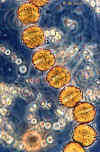Toxic Algae on the Rise on California Shores, Study Suggests

Neurotoxin-producing algae have been showing up in greater numbers and more often off the coast of Southern California, say researchers who have created a monitoring method in hopes of one day being able to predict when and where these toxic "red tides" will occur.
Called saxitoxin, the substance created by Alexandrium catenella algae, is "one of the most toxic biologically produced chemicals in the world," said study researcher David Caron, a professor of biological sciences at the University of Southern California's Dornsife College.
"Algal toxins are common along much of the coastal U.S., although the type of toxins and the timing of their appearance tend to vary from region to region," Caron told LiveScience.com.
Southern California shores have been seeing more of these algae blooms, though the cause of the increase is uncertain, Caron said. His lab at USC used water samples taken from King Harbor in Redondo Beach off the coast of California for the past four years coast to measure the amount of specific types of algae and monitor their seasonal changes.
"We have, what we fear, is a hot spot here for some types of toxic algal blooms," Caron said in a statement.
A. catenellaalgae are a bioluminescent species that contributes to the "red tide" phenomenon, which refers to the red discoloration of the water that can be caused by an abundance of this and other algal species. (Not all red tides are caused by toxic algae.)
The toxic algae are consumed by various shellfish and fish, including clams, mussels, anchovies and sardines. These contaminated marine creatures can then be captured and eaten.
Get the world’s most fascinating discoveries delivered straight to your inbox.
Caron warns that the ingestion of saxitoxins causes paralytic shellfish poisoning (PSP), which can be fatal to humans.
"That's when we get into trouble, when it gets into something we would eat," Caron said.
Paralytic shellfish poisoning is a recurring problem along the coasts of California, Oregon, Washington, and Alaska, but most of these states operate shellfish monitoring programs to prevent people from ingesting the toxic shellfish. In Alaska, at least three people reportedly have been hospitalized with paralytic shellfish poisoning since May.
"The numbers [of paralytic shellfish poisoning cases] are undoubtedly very low, because states carefully monitor shellfish that are brought to market for algal toxins," Caron said. "Because of the close watch kept by the departments of public health in the U.S., generally people are kept quite safe."
The California researchers also found that a different type of algae that produces the neurotoxin domoic acid has been increasing on the West Coast over the past decade. This toxin causes amnesic shellfish poisoning in humans, a life-threatening illness that is characterized by both neurological and gastrointestinal disorders. It is known to have caused thousands of marine animal deaths off California's shores over the past 10 years.
Since 2003, instances of animals becoming sickened by algal blooms in the California region have occurred almost annually, Caron said.
He is hopeful that his new tracking method will help shed light on the cause of these blooms. By thoroughly monitoring changes in environmental conditions, researchers may be able to determine why some harmful species of algae are blooming, as opposed to benign ones.
The study was published in the journal Applied and Environmental Microbiology in September.
You can follow LiveScience writer Remy Melina on Twitter @remymelina. Follow LiveScience for the latest in science news and discoveries on Twitter @livescience and on Facebook.
